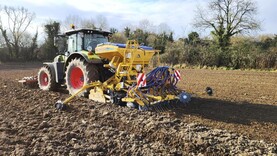The area planted to winter cereals has fallen dramatically across the country this autumn due to wet weather.
Agronomists from different regions told the Irish Farmers Journal this week that winter barley planting was back by anywhere from 10% to 90% on the 2022-23 area.
Some farmers have no winter crops planted and across the country winter barley area looks to be worst hit.
In parts of Wexford, winter barley area is back 90%. In Kilkenny some agronomists are reporting a 75% decline. Some progress has been made recently in east Cork to bring the area within last season’s levels. However, in south Cork some reports put winter cereal area back 50% on last season as farmers are still looking at unharvested spring crops.
Sixty per cent looked to be the highest percentage of winter wheat planted in most areas. Parts of the northeast have only 40% to 50% of their total winter cereals planted. In contrast, parts of north Cork, Tipperary, Laois and Offaly have 70% to 85% of crops in.
These figures are based on the percentage sown of the 2022-23 planted area. It is important to note that winter cereal area dropped dramatically in 2022-23 by approximately 34,297ha to 114,531ha. While we can’t place figures on the 2023-24 area yet, it is clear another drop is on the way.
On top of this, it is estimated that 10% to 15% of the area planted so far will need to be resown as crops failed to emerge or were lost where water lay on crops which had emerged.
Decline in production
Winter cereals have higher yields than spring crops and so the decline in area will significantly impact total cereal and straw production in 2024, as well as causing issues for spring seed availability and workload.
Agronomists are confident that farmers will continue to try and plant winter cereals, winter wheat in particular, if weather allows.
Some potato digging, maize harvesting and sowing was carried out last week where conditions allowed.






 This is a subscriber-only article
This is a subscriber-only article











SHARING OPTIONS: